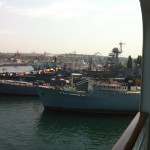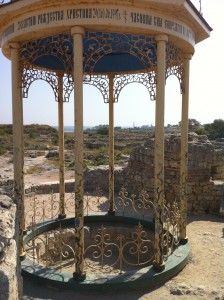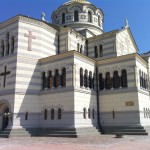
This is what I saw when I pulled back the curtains this morning. Sevastopol. The former home of the feared Soviet Black Sea Fleet, a port so important militarily in a nation with so little freedom even Ukrainian citizens had to have permission to enter and leave the city.
I think back to when I was in college and we were in the midst of the Cold War, if you had said that within just a few years the Soviet Union would collapse, Communism would be discarded or that in 2010 a cruise ship full of Americans tourists would be docking in Sevastopol next to its navy, no one would have believed you.
Such is history, fluid and full of twists and turns. It is malleable to those with the vision and initiative to shape it. To those with neither, it’s as inflexible as granite. Citizens of the kingdom of God are to be the former. Unfortunately, so many Christians have a philosophy of history that makes any attempt at change seem to them futile.

After a short visit to the monument commemorating the site of the scuttling of the Russian fleet at the Siege of Sevastopol during the Crimean War, we drove to Chersonesos, one of the largest remains of an Ancient Greek settlement in the world. Chersonesos was founded by the Greeks in the 6th century B.C. and was subsequently inhabited by the Romans, Byzantines and Russians.
Most interesting here was not the ruins, but seeing the place where Vladimir I was baptized. A gazebo has now been erected over the spot. As I’ve previously blogged, Vladimir’s conversion to Christianity led to Christianization of Russia. From the perspective of the history of Russia this spot was the most important treasure of Chersonesos, but our guide glossed over it. In fact, I had to break away from the rest of the group to see it.
I don’t blame her. I’ve noticed this in other guides we’ve had from the former USSR. A few years back we were in the Hermitage in St. Petersburg and our guide showed us Rembrandt’s Return of the Prodigal Son. Her explanation on the meaning of the parable was so off it could only have resulted from a guess birthed out of an ignorance of Christianity. This ignorance is not stupidity but a lack of knowledge that is the result of Communism’s atheistic indoctrination of its people.

Our last stop at Chersonesos was the newly renovated and rededicated St. Vladimir Cathedral. The cathedral is a symbol of the rebirth of Christianity in the Ukraine, setting as it does, just yards away from where Vladimir was baptized. The inside was beautiful and ornate, but no photographs were allowed, so you will have to take my word for it.
The people of Ukraine are, for all practical purposes, a blank canvas religiously. From what I’ve seen in St. Petersburg, I suspect this is true of much of the former USSR as well.
Until tomorrow… GS
